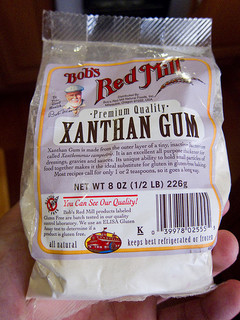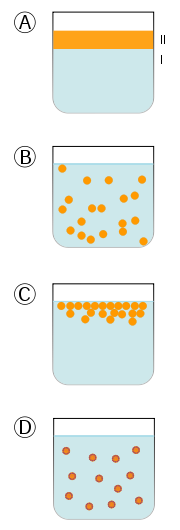Now who all is in on this whole gluten-free diet? If so, you better start thanking this guy right here...

Try imagining pouring out your
salad dressing from its container and all you get is the oil,
followed by the rest of the ingredients, yum right?
Or how about when you consume frozen food and all you
get once they are heated up is mush and experience none
of the pleasurable feelings of the food, yum right? No,
ew!
Well you can give a huge shout out to Xanthomonas
campestris, more specifically to its “oozy” outer
coating that is composed of primarily a polysaccharide.
Initially this “ooze” is secreted by the bacteria to be
used as a protective layer. This exopolysaccharide
slime is used to defend off attack from bacteriophage as
well as serve as a barrier from environmental damage
during its dormant stages in life, usually during winter
months because Xcc doesn’t form any type of
endospores or cysts. The polysaccharide the makes
up the "oozy" outer coating is more formally known as
xanthan gum, a common food additive.
The use of xanthan gum is very beneficial to the food
industry however it is a complex process to extract this
heteropolysaccharide from Xcc. For proper
execution of this process a multienzyme system is
required. Initially there is an uptake of
carbohydrate substrates through active transport or
facilitated diffusion from the outer coating. The
microbial strains that are selected are held in a
long-term storage in order to preserve the correct
properties needed for further processing. A small
fragment of the culture is then used and grown into an
appropriate inoculum for a
bioreactor. While the medium is being mixed
and ventilated the polymer produces extracellularly.
It is difficult to give a specific amount of xanthan
that will be produced because that mainly relies on the
initial bacteria strain and the exact mechanism used to
produce the polymer. After fermentation occurs,
varying from one to four days, there is a broth found as
the byproduct. Within this broth are xanthan,
bacterial cells, and other components. Multiple
filtrations are done to separate out the main cells.
Isopropanol is then added to form a precipitate of
xanthan, which is then dried and packaged for
manufacturing.
Xanthan gum’s structure consists of a primary structure
consisting of repeated pentasaccharide units formed by
two glucose units, two mannose units, and a glucuronic
acid unit. Its main chain consists of
beta-D-glucose units with linkages at the 1 and 4
positions, very similar structure to cellulose.
The repeating segments of pentasaccharide units give
xanthan gum its backbone, which is a unique
characteristic of this heteropolysaccharide. Below
is the overall structure of xanthan.
Image copyright Antonio Zamora


 Xanthan
gum is a widely used food additive in the food industry. It is
a common replacement for common food additive, gluten. Whether
it is based on being allergic to wheat or just simply taking part in
a gluten-free diet, xanthan gum is most likely your predominate
substitute. It
has multiple uses, specially used in adding viscosity and
suspension, and to stabilize mixtures of liquids within food
products. Xanthan gum is a polysaccharide used not only in the
food industry but also in agriculture, cosmetics and
pharmaceuticals. Xanthan gum is identified as a cream colored
powder which constantly holds a high viscosity within both hot and
cold solutions. This characteristic gives xanthan gum the
ability to aid in many different applications. Xanthan gum is
approved by the United States Food and Drug Administration to be
used in human food which allows it to
Xanthan
gum is a widely used food additive in the food industry. It is
a common replacement for common food additive, gluten. Whether
it is based on being allergic to wheat or just simply taking part in
a gluten-free diet, xanthan gum is most likely your predominate
substitute. It
has multiple uses, specially used in adding viscosity and
suspension, and to stabilize mixtures of liquids within food
products. Xanthan gum is a polysaccharide used not only in the
food industry but also in agriculture, cosmetics and
pharmaceuticals. Xanthan gum is identified as a cream colored
powder which constantly holds a high viscosity within both hot and
cold solutions. This characteristic gives xanthan gum the
ability to aid in many different applications. Xanthan gum is
approved by the United States Food and Drug Administration to be
used in human food which allows it to
 be used in a variety of food
and product production. With the high demand of frozen food
and mixtures of liquid there is a need for a food additive that can
produce a unique texture expression, viscosity, flavor release,
appearance, and control water properties, and that food additive is xanthan gum. Its most common characteristic would be its
ability to keep oily mixtures mixed together when needed, such as
within dressings. It allows settling of higher density
ingredients but once mixed xanthan gum holds the ingredients
together long enough to pour evenly out of the container, this
process is commonly known as a pseudoplastic property in solutions.
See the table below for more examples of how xanthan gum is used in
the food industry as well as other manufacturing departments.
be used in a variety of food
and product production. With the high demand of frozen food
and mixtures of liquid there is a need for a food additive that can
produce a unique texture expression, viscosity, flavor release,
appearance, and control water properties, and that food additive is xanthan gum. Its most common characteristic would be its
ability to keep oily mixtures mixed together when needed, such as
within dressings. It allows settling of higher density
ingredients but once mixed xanthan gum holds the ingredients
together long enough to pour evenly out of the container, this
process is commonly known as a pseudoplastic property in solutions.
See the table below for more examples of how xanthan gum is used in
the food industry as well as other manufacturing departments.

After understanding the significance of xanthan gum in the food
industry, the importance and significance of Xanthomonas
campestris is looked at on a whole new level. This
normally known plant pathogen is actually held at high demand within
human food production. It can be stated that Xcc is
sustainable as a food source due to the applications that its
byproduct, xanthan gum has with a multitude of different products.
_____________________________________________________________________________________________________
Wow that is one cool organism if you ask me. On one side it is
a devastating plant pathogen but then can be a successful and
desirable food additive for the human food production. I
wonder what other cool facts Xanthomonas
campestris can have!
-- HOME -- REFERENCES -- CONTACT ME -- MULTIPLE ORGANISMS --





